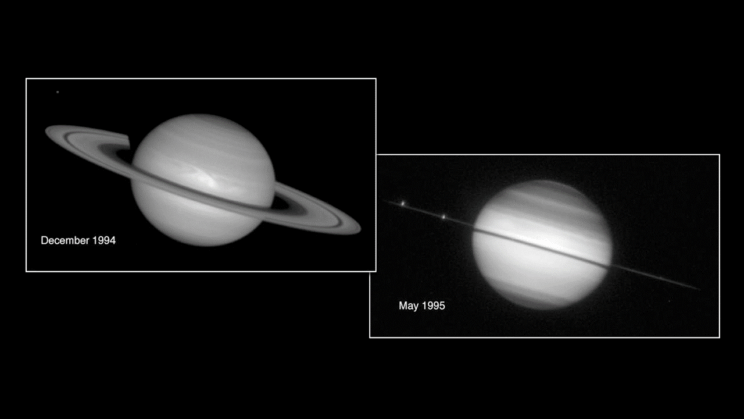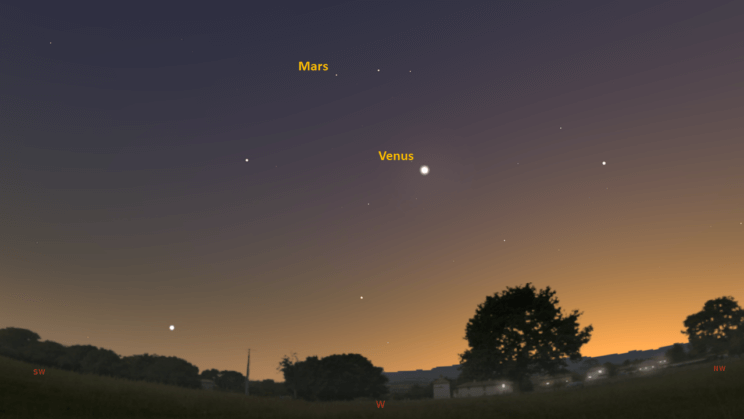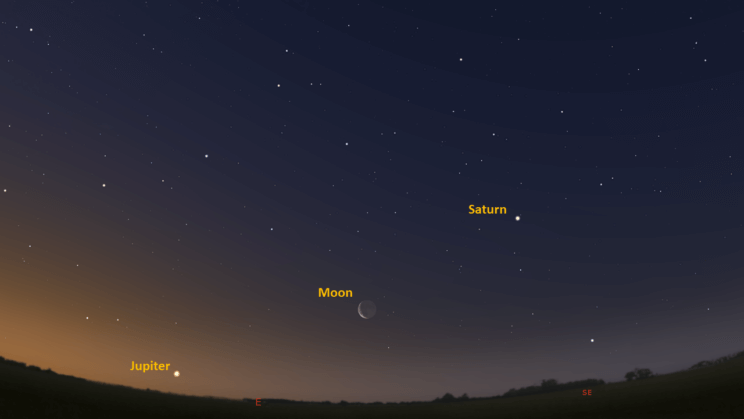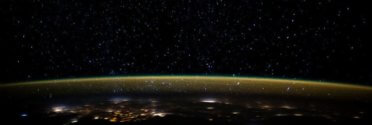This is the Saint Louis Science Center’s NIGHT SKY UPDATE for the week of Friday, May 12, 2023.
Information updated weekly or as needed.
Times given as local St. Louis time which is Central Daylight Time (CDT). For definitions of terminology used in the night sky update, click the highlighted text. If relying on times posted in Universal Time (UT), St. louis is -5 hours when CDT.
Public Telescope Viewings
As part of the Saint Louis Science Center’s First Fridays, weather permitting, the St. Louis Astronomical Society and the Science Center will set up a number of telescopes outdoors and be on-hand to answer your questions. Telescope viewing begins once it is dark. Regardless of the weather on June 2, join us indoors in our planetarium theater for “The Sky Tonight”. Showtime is at 7 p.m.
Observing Highlight of the Week

A Saturn ring plane crossing imaged by the Hubble Space Telescope in 1995. Image credit: NASA, STSci.
Jupiter and Saturn are returning to morning skies after disappearing for a short time due to solar conjunction. Saturn has been visible for a while now and Jupiter is becoming visible just before sunrise if you have clear eastern horizons.
Saturn will be best this year in August and September. Saturn currently rises around 3:00 a.m. Each week Saturn will rise about 20 to 30 minutes earlier than it did the week before. By June 24, you will find Saturn rising around midnight. Saturn reaches opposition on August 27, 2023, which is when the planet will be brightest. As we approach opposition with Saturn, the planet will rise as the Sun sets. Those with telescopes can watch Saturn’s rings over the next two years as we see them progress towards an edge on appearance. Ring plane crossings occur for Saturn when it reaches equinox. This occurs approximately every 15 years. The next ring plane crossing will occur in March 2025.
Jupiter is just starting another apparition. For most of us, tree lines and buildings will still obscure views of this giant world. By the end of May, Jupiter will rise early enough we should be able to see it just before sunrise. Like Saturn, Jupiter will rise roughly 20 to 30 minutes earlier than it did the previous week. Right now, Jupiter rises around 5:00 a.m., which is less than an hour before sunrise. By the end of May, it will rise a little before 4:00 a.m. By August, Jupiter rises around midnight. Jupiter is best in October and November this year as it reaches opposition on November 2, 2023.
Lastly, new moon counts were announced for both planets. About a week ago, the numbers were sitting at 92 moons for Jupiter and 83 moons for Saturn. Now Jupiter has 95 while Saturn has 124. It is expected that later this month more moons for Saturn will be announced bringing its total to 145. If you would like to learn more about these discoveries, Sky and Telescope has published an article discussing the topic. You can find that article at https://skyandtelescope.org/astronomy-news/new-observations-double-saturns-irregular-moons/
The Sun and Moon

The Moon as seen from the International Space Station, on July 31, 2011.
Credit: NASA
Sunrise is at 5:52 a.m. on Friday, May 12 and sunset is at 8:03 p.m. providing us with over 14 hours of daylight. Even after sunset, light from the Sun will dimly illuminate our sky for roughly 1 hour and 50 minutes. This period is called twilight, which ends around 9:49 p.m. this week. For those with a sundial, local noon occurs around 12:57 p.m. this week.
| Day | Sunrise | Sunset | ||||||||||
|---|---|---|---|---|---|---|---|---|---|---|---|---|
| 12-May | 5:52 a.m. | 8:03 p.m. | ||||||||||
| 13-May | 5:51 a.m. | 8:04 p.m. | ||||||||||
| 14-May | 5:50 a.m. | 8:05 p.m. | ||||||||||
| 15-May | 5:49 a.m. | 8:06 p.m. | ||||||||||
| 16-May | 5:48 a.m. | 8:07 p.m. | ||||||||||
| 17-May | 5:47 a.m. | 8:07 p.m. | ||||||||||
| 18-May | 5:47 a.m. | 8:08 p.m. | ||||||||||
| 19-May | 5:46 a.m. | 8:09 p.m. | ||||||||||
| 20-May | 5:45 a.m. | 8:10 p.m. |
Moon
Moonrise for Friday, May 12 is at 2:18 a.m. and moonset occurs at 12:27 p.m. On Friday, May 12, the Moon will exhibit a waning crescent phase with 46% disk illumination. New moon occurs on May 19, 2023, at 10:53 a.m.
International Space Station (ISS) Observing

There are several visible passes of ISS from St. Louis for the week of May 12. They occur during morning and evening hours. The best passes for this week are listed below. Use the table below for information about these passes.
Catch ISS from St. Louis starting Friday, May 12
| Date | Starts | Max. altitude | Ends | |||||||
|---|---|---|---|---|---|---|---|---|---|---|
| Time | Alt. | Az. | Time | Alt. | Az. | Time | Alt. | Az. | ||
| 15 May | -2.1 | 4:33:31 | 19 | SSW | 4:33:31 | 19 | SSW | 4:34:58 | 10 | S |
| 15 May | -2.1 | 21:10:32 | 10 | WSW | 21:13:39 | 37 | NNW | 21:16:48 | 10 | NE |
| 17 May | -0.8 | 21:10:55 | 10 | WNW | 21:13:22 | 19 | NNW | 21:15:48 | 10 | NNE |
Magnitude (Mag): The Measure of brightness for a celestial object. The lower the value is, the brighter the object will be.
Altitude (Alt): The angle of a celestial object measured upwards from the observer’s horizon.
Azimuth (Az): The direction of a celestial object, measured clockwise from an observer’s location with north being 0°, east being 90°, south being 180° and west being 270°.
For information about ISS flyovers and other visible satellites, visit www.heavens-above.com
Detailed information regarding all unmanned exploration of our universe, missions past, present, and planned, can be found at Jet Propulsion Laboratories:
The Visible Planets

Looking west at 8:30 p.m. on May 14, 2023. Credit: Stellarium, EG

Looking Southeast at 5:00 a.m. on May 15, 2023. Credit: Stellarium, EG
This week, three naked eye planets will be visible. Venus and Mars are found in the west after sunset. Saturn is now visible in the southeast about 30 minutes before sunrise.
Venus
Venus is well into its current evening apparition. Venus will be a bright target in the west after sunset until August 2023 when it approaches inferior conjunction. This week, look for Venus in the west about 20 minutes after sunset. Venus sets at 11:37 p.m.
Mars
Mars now rises before sunset, becoming visible once it is dark. Look for it high in the west about 30 minutes after sunset. Mars sets at 12:47 a.m.
Saturn
Saturn rises at 2:45 a.m. Start looking for Saturn about 30 minutes after it rises. If you have lots of trees or buildings, you may have to wait an hour or so after it rises before it will be visible.
James S. McDonnell Planetarium
Night Sky Update: May 12-20, 2023







